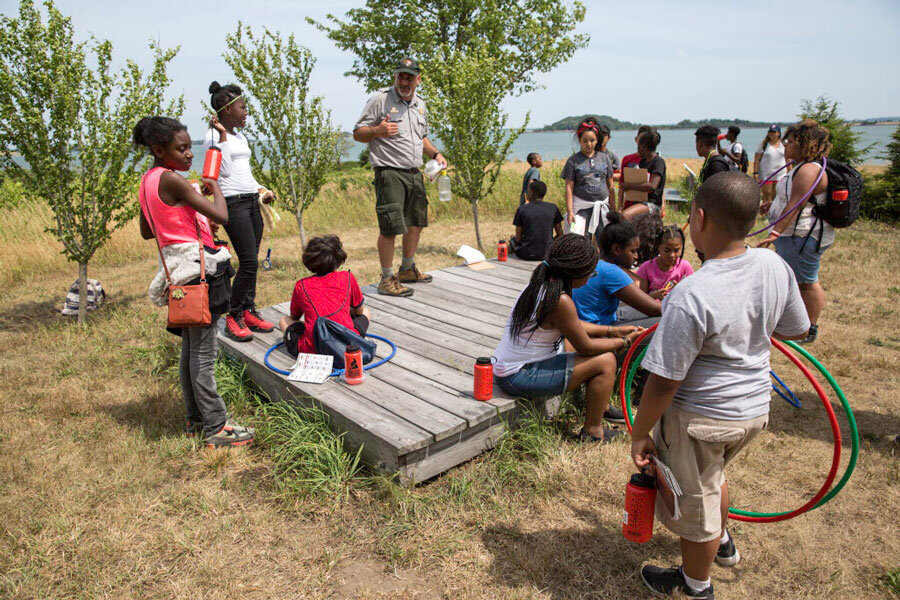The Boston summer school students reach by ferry – not bus
Loading...
| Boston
Marielys Diaz strolls laconically through the closely mowed brown Thompson Island grass on a still and sticky, 90-plus degree day.
It may not look like it, but the Boston teen is in school.
She’s just finished a class where she learned to identify biodiversity in a meadow. When she first came to the program as a rising-fourth grader from Orchard Gardens school in Roxbury, a majority African-American neighborhood of Boston, she never wanted to spend much time outside walking or exploring nature. Now, she says, it’s her favorite thing to do.
This isn’t your father’s summer school. Instead of drilling kids on subjects as they and their teacher bake in hot classrooms, programs like the one on Thompson Island take a more holistic approach to education – teaching not just math and science but also how to reason and analyze.
Education experts say this approach helps kids in a myriad of ways – from building their appreciation for the natural world to instilling character traits required to succeed the rest of the year. There are also more practical considerations, such as making sure they get at least two meals per day.
The five-week program also offers low-income students the kind of immersive learning experience normally only available to kids whose parents can scrape together a spare $2,000.
Marielys is among the one-third of American students attending a summer learning program and she’s doing so at a time when it’s never been more important, especially for kids from low-income families. The achievement gap on standardized test scores between them and their higher-income peers has widened by at least 30 percent for students born in 2001 compared with those born in the mid-1970s.
"If a student isn’t excelling in one kind of environment September through June, why would we go and stick them back in that same environment for the whole summer?" says David McAuley, program director of summer learning for Boston After School and Beyond.
When the classroom is an island
On a hot Monday morning, some 70 kids clamber onto the ferry that will take them one about mile out into Boston Harbor through the fresh, salty breeze. Their excited chatter is loud enough to be heard above the rushing wind as the boat chugs out into the harbor. Some lean over the stern tracing the wake with their eyes back to the city skyline.
Marielys recounts how the STEM-based (science, technology, engineering, math) summer learning program here on the island has changed her life over the past four summers.
“Every time I come here, if I fail[ed] a class [in school], I come back [the next year] and I pass,” Marielys says with an off-the-cuff pride.
Experts say a leading driver of this widening gap is the so-called “summer slide” – the average student comes back after summer vacation a month behind where they were when school got out. For example, two-thirds of the reading achievement gap is due to summer learning loss, according to the National Summer Learning Association (NSLA).
While middle- and upper-class parents might fight summer slide by enrolling their children in coding, language immersion, or music camps, with extra trips to the museum and library for good measure, low-income students are often stuck at home, where their parents know they are safe. There, they self-supervise or take care of younger siblings while their mom or dad is at work – often with a TV or a smartphone to keep them company.
There are still cheaper summer school options that make sure kids academically pass into the next grade, but those don't offer the “statistically significant growth in areas such as communication, relationships, initiative, and engagement in learning,” Boston After School and Beyond says it has measured in its students.
Americans' nostalgia for summer vacation as a lazy idyll full of trips to the beach or sleepaway camp not only doesn't match the reality of these students – it's working against them, experts say.
“There’s prevailing thinking in society that summer is a time for vacation, and that thinking and that ideal still crosses income lines,” says Sarah Pitcock, National Summer Learning Association. “That’s really working against kids … where you see lower income kids falling behind because they’re just not getting that intentional exposure to learning.”
In many parts of the country, those parents whose child would most benefit from a summer program are those who can least afford it. According to a RAND Corporation study on summer learning, a quality program can cost between $1,109 and $2,801. However, in a select but growing number of cities like Boston, educational and community organizations have concocted ways of overcoming financial and other barriers to summer learning. BPS officials say the extra hit to the budget is worth it, because longitudinal studies shows summer learning works. And American parents agree. Eighty-five percent of parents support public funding for summer learning programs, with support above 75 percent in every state, according to a 2015 Afterschool Alliance survey.
A more holistic approach
Boston Afterschool and Beyond, for example, has helped coordinate funding of a joint three-way initiative between Outward Bound, which runs the facility on Thompson Island; Boston Public Schools; and the National Parks Service. This means Marielys and her peers can all attend a top-notch program for free. Outward Bound also feeds them breakfast and lunch, solving a widespread problem for many low-income kids during the summer.
The idea, says Mr. McAuley, is to provide the most at-risk kids with a holistic education. That means the staff of each partner organization are helping foster different elements of the children’s development: in-class academic acceleration; building social and emotional skills like perseverance, teamwork, and critical thinking, needed to be a good learner and get along with others; and connecting the science theory they’re learning with the real outdoors.
“It’s definitely the model that we recommend and support districts to implement,” Ms. Pitcock says. “I think what’s really interesting about the Boston model is the way the goals and the themes of the program are integrated throughout the day.”
The kids are in their second week of a Monday-to-Friday program that runs from 9 a.m. to 4 p.m. over five weeks – a length of time McAuley says studies show is ideal for halting the summer slide. The theme for this year’s program is “How tough is life?” This week, the theme is adaptation and survival. As many students are from tough or unstable environments, they are encouraged to think about the theme in relation to their own lives.
One of the seven teachers, Shauntell Dunbar, is a Jamaican-American who’s just completed her first year as a first-grade teacher. Her dedication to reaching kids by meeting them on their level, sometimes literally under their desks, was noted in a recent write-up in the Boston Globe.
Ms. Dunbar says she knows what it’s like to feel misunderstood by teachers – one Somerville teacher told the principal Dunbar was unteachable because she didn’t know English. (She actually did, but just had a thick accent.) She credits a Boston Public Schools teacher for helping bring her out of her shell. Now, she wants to return the favor to kids who feel like school is leaving them behind.
Basic science, with a twist
Today the class of 12 sits around a U-shaped desk formation. In line with the adaptation theme, Dunbar has the class test whether a clothespin, a fork, or a spoon – symbolic of the how different birds’ beaks have evolved to suit the way they collect food – are most effective at gathering rice from a bucket. Later, Ranger Matt Hagopian, a middle-school science teacher who does this as a summer job, will take them for their hands-on outdoor class on biodiversity to talk about how it helps birds survive in the wild.
The lesson is a basic science class. Most kids appear engaged – especially for a hot summer morning. But it’s what happens when a student acts up – speaking out of turn or speaking harshly to another student – that shows why the Thompson Island program is different from the traditional classroom environment.
Dennis Sacharis Pere is funny and witty, but when he consistently calls out in class, Sam Carlson, the Outward Bound facilitator responsible for helping the kids to grow socially and emotionally, demands he pay respect to Dunbar and the other students, pointing out that he didn’t give them “props."
Both Dunbar and Carlson are clearly in control, but at the same time the social and emotional lessons they teach don’t sound like scolding.
Jahkhi Waters, a soft-spoken student, summarizes the approach.
“In school, it's like work and no fun, you just gotta work hard, and hard, and hard, but on Thompson Island, Thompson Island recognizes how other kids feel, like sometimes the kids get stressed out.”
Research by RAND shows that the approach works. Students who take courses like the one on Thompson Island have an advantage in math over those who don’t keep learning in the summer. Boston After School and Beyond also has data showing advantages in reading and social and emotional outcomes.
The report says demand for quality summer learning opportunities still far outstrips supply. Cost of programs varies wildly between states from around $115 per student in Idaho versus $639 in Nevada.
In Massachusetts, considered to be on the leading edge of summer learning, mayors and city leaders in Boston and surrounding suburbs earlier this year backed a state bill that would aim to expand access to education like the Thompson Island program from the roughly 5,600 children served in 2015, to around 20,000 students.
For students like Marielys, the rising 7th grader from Roxbury, the impact of such programs can be profound.
In her four years coming to the Thompson Island summer program, Marielys says she has gained a sense of belonging, and an appreciation for nature and learning. Given her “veteran” status, some of the staff are helping her work toward becoming a leader among her her peers.
She’s already talking about Green Ambassadors, a paid Thompson Island program that allow students 15 and older to gain experience in the green jobs sector.
“We'd be helping out building stuff. We’d be out on the islands doing work and you'd get paid more than $2000 for the whole summer,” she says.








